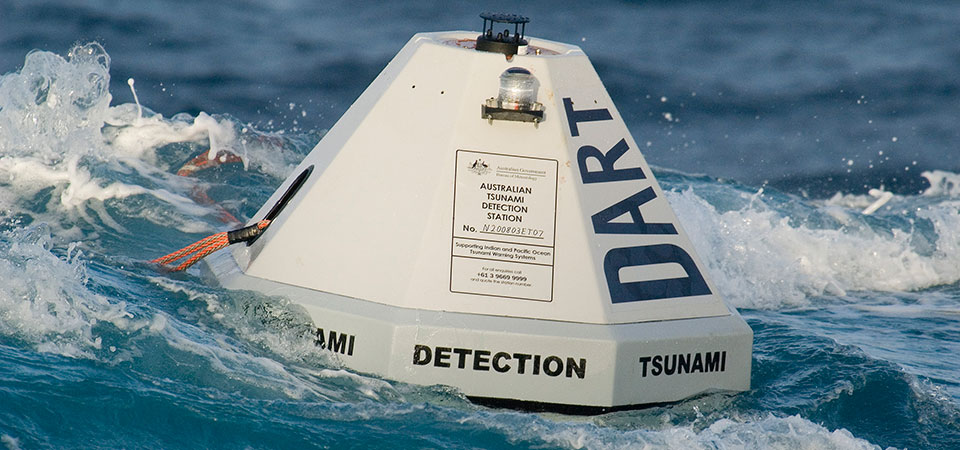Tsunamis
Ocean Shorts: Episode 8

Monitoring Tsunamis
DART® real-time tsunami monitoring systems, developed by PMEL, are positioned at strategic locations throughout the ocean and play a critical role in tsunami forecasting.
Transcript
HOST: Welcome to Ocean Shorts where we revisit and share with you a few minutes from popular Making Waves and Diving Deeper podcasts. Today, I'll revisit our episode on tsunamis with Russell Jackson from the NOAA Office for Coastal Management.
Let's listen in.
HOST: Russell, so what causes tsunamis?
RUSSELL JACKSON: Well Kate, tsunamis are commonly generated by earthquakes in coastal and marine regions. And most tsunamis are produced by large, usually greater than a seven on the Richter scale, earthquakes that are associated with movement along the oceanic and continental plates. They frequently occur in the Pacific Ocean, Pacific Basin, where there's dense oceanic plates that slide under the lighter continental plates. And when these plates fracture and move, the vertical movement of the plate actually transfers a lot of energy from the sea floor to the ocean and actually causes the wave to be created.
HOST: Such a tragic event. Are there other ways to generate tsunamis?
RUSSELL JACKSON: Yeah, there are a few other ways. One in particular that there's been a lot of experiences happened in the past are from underwater landslides associated with smaller earthquakes, they're also capable of generating destructive tsunamis. In Papua New Guinea in 1998, there was a tsunami that devastated that area. It was generated by an earthquake that registered about a 7.0, which usually would not generate a huge tsunami, but that earthquake apparently caused an underwater landslide that created waves over seven meters high that struck the coastline, devastated over three coastal villages, completely wiped it clean to where there was nothing but sand located on those islands, and killed over 2,200 people.
Other large-scale disturbances of the sea floor can also generate tsunamis such as explosive volcanoes and even potentially asteroids making impact. Fortunately we don't have a whole lot of asteroids making impact here, but there was an eruption of a volcano in Indonesia called Krakatoa in 1883 that produced a 30-meter tsunami and it killed over 36,000 people.
HOST: If a tsunami wave is relatively small out in the deep ocean, what creates these larger coastal waves that we often hear about?
RUSSELL JACKSON: Well, the height of the wave when generated, especially in the deep ocean, is very small, usually less than a few feet. And as these waves approach the coast, their speed starts to decrease and the amplitude, or height, increases. When the waves of a tsunami approach land, their appearance and behavior become dependent on several factors. Two of the most important factors are topography of the sea floor, or what we refer to as bathymetry, and the actual slope of the shoreline.
So as a tsunami encounters shallow waters surrounding the shoreline, its height can increase from less than a meter to rapidly over 15 meters. So depending on the depth of the water in which the tsunami is traveling, it can actually attain speeds of 500 miles an hour.
HOST: That's all for today's Ocean Shorts. Thanks for joining us! For more information on tsunamis, see our show notes at oceanservice.noaa.gov/podcasts.html. Be sure to join us for our next episode.
